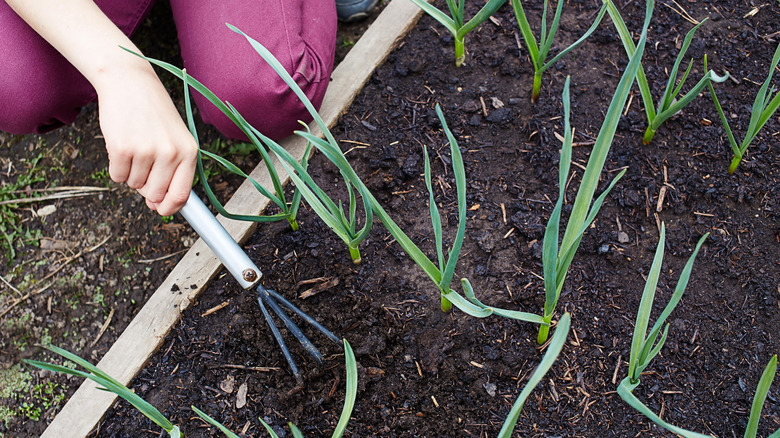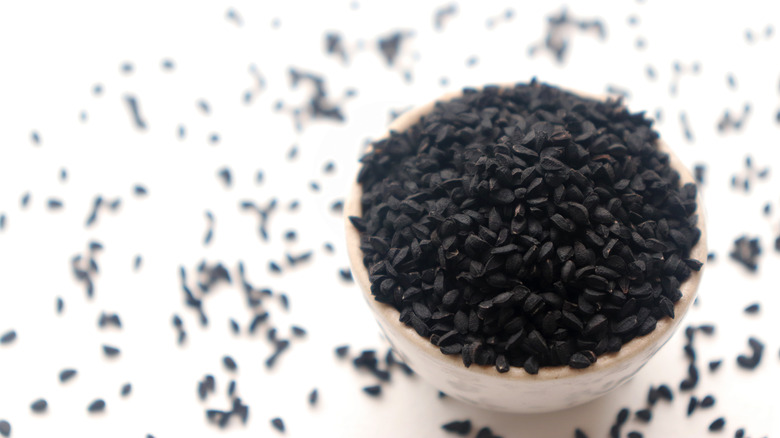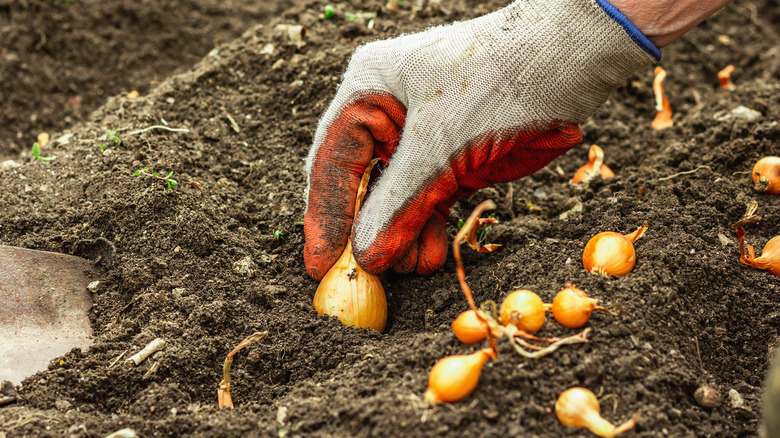Onion Sets Vs Onion Seeds: What's The Difference And Which Is Better For Your Garden?
Onions are one of nature's most powerful plants, and not just because of their pungent scent. Eating onions can give you a healthy boost of antioxidants, vitamin C, folate, and potassium, and several studies have even shown their ability to reduce your risk for some cancers (via Healthline). In addition to being good for you, onions are also rather easy to grow for beginner gardeners, so if you're looking to add more to your plate, consider adding more to your vegetable garden first!
Onion seeds, produced by buds that flower in the spring, are tiny, dark seeds that you can purchase in packets or harvest from adult plants. Onion sets are essentially mini-onions or immature bulbs that still have a lot of room for growth. There are positives and negatives for both methods, so it's important to consider which stage of the onion will thrive best depending on your gardening skills and seasonal timing. Here's what you need to know about onion seeds and onion sets to make the right decision.
Onion seeds take time
Overall, onion seeds require a little more care and planning than onion sets, but they have some noteworthy advantages. For one, a package of onion seeds is much cheaper than onion sets, and you may even be able to use seeds from last year's onion crop. It's also easier to find rare varieties of onion seeds. Secondly, onion seeds can and should be sown earlier in the season, sometimes as early as December or January, depending on your climate zone.
The downside of onion seeds is that they need a warm environment to spark growth, so it's best to start them in a greenhouse or indoor area until the sprouts are established. Sprouts will take about six weeks before they're ready to transplant. Unfortunately, onions grown from seeds are more susceptible to diseases, especially during the precarious weeks of early growth. Once the seeds have sprouted and spring brings warmer soil, the baby onions can be planted 4 to 5 inches apart in raised garden beds or in the soil. On the positive side, seed-grown onions actually stand a chance of growing much larger than onion sets. They're also less prone to "bolting," a stress reaction that causes the onion to shoot up a sudden bloom in a dying effort to reproduce. If all of your seeds succeed, you can get a hefty crop from just one packet.
Sometimes onion sets are easier
Onion sets have distinct advantages for people who would rather skip the inconvenience of sowing and sprouting seeds. Sets are incredibly easy to plant and grow — simply pop them into the soil and let nature do the rest. Onion sets are still immature bulbs, but they've already made it past the risky seedling stage, and they have a lot of potential to keep growing after they're planted, usually early in the spring or fall. Onion sets are less likely to fail as a result of disease, so the odds are in your favor that you'll get a healthy crop and have an earlier harvest time.
However, onion sets still have some drawbacks worth considering. They're more expensive per plant, and it's difficult to find them in a wide variety. Most onion sets also won't grow as big as seed-started onions, and their planting date is really important to avoid environmental stress and bolting. To determine whether onion seeds or sets are right for you, you'll have to be honest with yourself about your gardening skills and harvest expectations. Sets are easier and faster for impatient gardeners, but seeds are more affordable and have the chance to grow larger. It might be worth trying both this season to see which works best for you!


